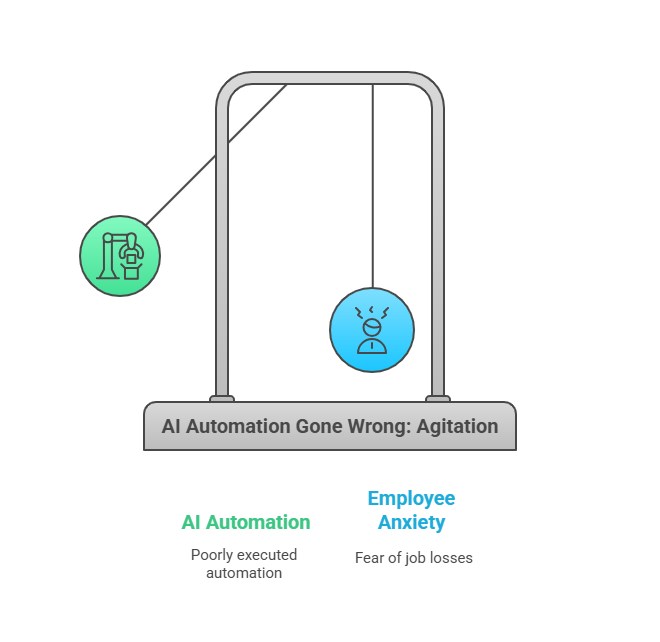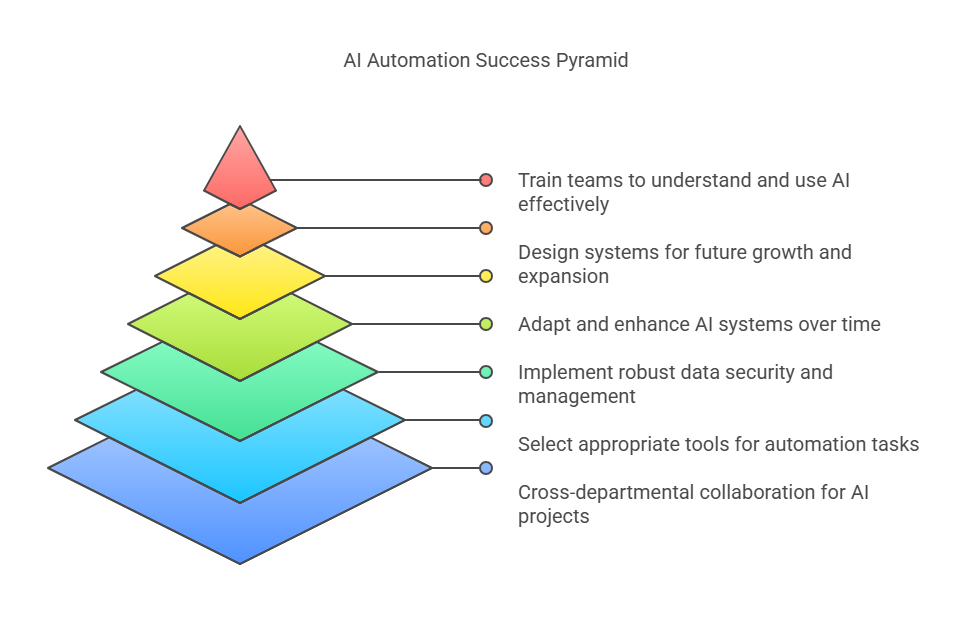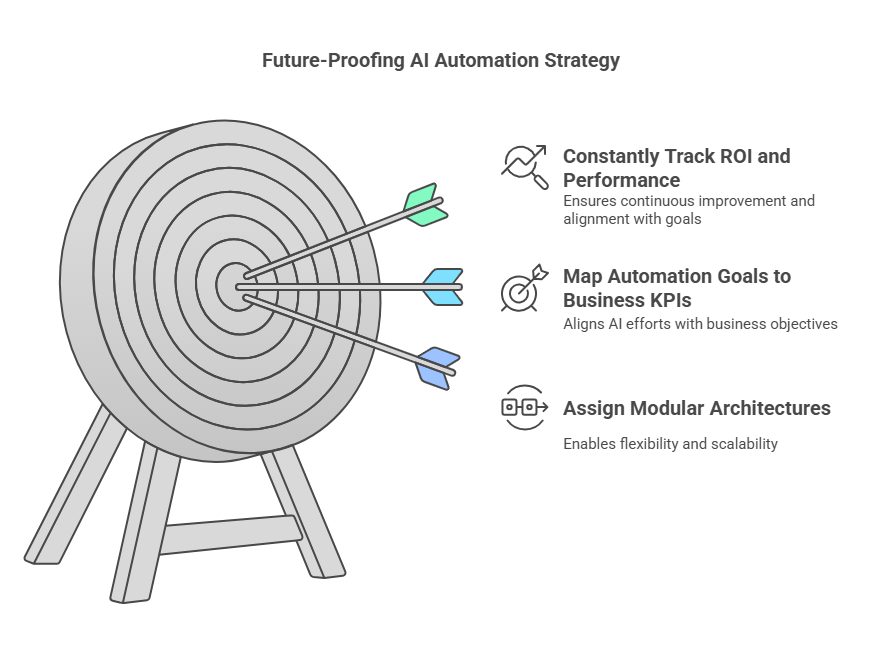The demand for AI automation best practices is higher than ever. In a world where AI is revolutionizing industries, scaling automation effectively is the next big hurdle. While it’s clear that AI can drive massive ROI, many organizations are struggling to move beyond pilot projects.
Why?
Because most AI implementations start small, siloed, and unscalable. Teams lack alignment, strategies lack sustainability, and automation efforts stall before they even start to grow.
Let’s break down how to fix that.
The Problem: Scaling AI Automation Is More Complex Than It Appears
Even with powerful platforms and promising pilots, many companies:
- Can’t align their automation strategy across departments
- Lack sustainability or change management
- Face poor ROI due to short-term thinking
In other words, AI automation best practices are not being followed — and the consequences are clear.
The Agitation: The Hidden Cost of Getting AI Automation Wrong
Let’s see what can happen if the AI automation architecture is not built for scalability:
- Bot sprawl from disjointed tools
- Maintenance disaster and technology debt
- Expensive rebuilding as systems progress
- Decreased trusts in team AI results
- Decreased user uptake of intelligent systems
If the business does not use best practices for automation, they will find themselves in a wheel without the real opportunity for transformation, repeatedly doing pilot deployments over and over again. This may have consequences in a competitive world and is a risk you don’t want to take.

The Solution: AI Automation Best Practices for Scalable Success
Now let’s delve into the tactics which enable scaling AI automation with intelligence, efficiency, and future value.
1. Use Cases Must Be Right
Not all processes should be automated. Consider automating:
- High-volume, repetitive tasks
- Processes that have measurable impact on your business
- Workflows that touch multiple departments and tools
2. Form An Automation Team With All Departments
For AI automation to be effective all departments should be:
- IT and engineering
- Business ops
- Process owners and stewards
- Compliance and Risk
A Center of Excellence (CoE) will govern, share knowledge, and enforce best practices for AI automation across your organization.
3. Pick The Right AI Automation Tools
Choose platforms that allow for:
- Easy low-code/no-code development
- Ease of integration with your current technology
- Easy scalability to multiple departments and functions
- Support for AI agents and intelligent automation
4. Emphasize Data Governance and Security
As your systems grow in capability, they will require greater amounts of sensitive business data.
Best practices:
- Cleaning and labeling training data
- Using role-based access
- Complying with regulations such as GDPR, HIPAA, and respectable industry standards
5. Build for Change and Continuous Improvement
Future-ready AI automation systems:
- Support process change without manual intervention
- Retrain AI models from new data
- Allow or accommodate choices of human-in-the-loop exceptions.
Use process mining and AI observability tools to discover friction points in workflows and improve continuously.
6. Invest in Scalable Architecture
Don’t settle for the limits of on-premise architecture, migrate to:
- Cloud-native platforms
- Serverless (like AWS Lambda)
- No restrictions to scale but usage rates, not on licensing
7. Train Your Teams and Build AI Literacy
Adoption is the key for any type of automation. Without it, even the greatest automation will fail. Providing training helps:
- Workshops on AI tools
- Documentation on processes
- Internal champions to help teams
AI copilots, UIs that non-techy users can understand.

How to Future-Proof Your AI Automation Strategy
1. Assign Modular Architectures
Build your automation with plug-and-play modules. This makes it easy to upgrade, add to or swap out any part of your system without changing everything.
2. Map Automation Goals to Business KPIs
Ensure that every AI initiative maps to a measurable goal:
- Increase revenues
- Reduce expenses
- Improve CX
- Enhance productivity
3. Constantly Track ROI and Performance
Track your:
- Time saved
- Completion rates
- Error reduction measures
- Employee satisfaction using dashboards.

Conclusion: Learn to Scale Intentionally, not Chaotically
AI automation isn’t only about technology—it’s about people, processes, and purpose. By implementing these AI automation best practices, you’ll create a system that:
- Scales across departments
- Responds to change
- Provides ongoing value
- Prepares your way of business for the future
👉 Book your free automation audit today
FAQs
Q: What are AI automation best practices for 2025?
In 2025, best practices include choosing scalable tools, ensuring data governance, creating a CoE, starting with high-ROI use cases, and integrating continuous improvement strategies using AI observability and process mining tools.
Q: How do I scale AI automation across my enterprise?
Start by identifying cross-functional workflows, involve business and tech stakeholders, and invest in a cloud-based automation platform that supports low-code development and integration with your existing stack.
Q: What’s the difference between RPA and intelligent automation?
RPA automates rule-based tasks, while intelligent automation includes AI capabilities like natural language processing, decision-making, and self-learning, making it more scalable and adaptive.
Q: What are the risks of poor AI automation implementation?
Risks include bot sprawl, redundant tools, high maintenance costs, low adoption rates, and limited ROI. These can be avoided by following AI automation best practices.
Q: How do I choose the right AI automation platform for my business?
To choose the right AI automation platform, evaluate your business needs, scalability requirements, ease of integration with your existing tech stack, and the level of AI capabilities (like intelligent decision-making, NLP, or machine learning). Also consider support, security, and whether it offers low-code/no-code development to empower your teams. Comparing options using industry reports like the Gartner Magic Quadrant can help.